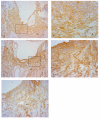Integrins in the optic nerve head: potential roles in glaucomatous optic neuropathy (an American Ophthalmological Society thesis)
- PMID: 17471356
- PMCID: PMC1809896
Integrins in the optic nerve head: potential roles in glaucomatous optic neuropathy (an American Ophthalmological Society thesis)
Abstract
Purpose: To demonstrate that specific distributions of integrin-based focal mechanoreceptors exist in primate optic nerve heads, suitable for translating stress and strain into the cellular responses of glaucomatous optic neuropathy.
Methods: Normal human (N = 20) and rhesus monkey (N = 14) optic nerve heads and 32 glaucomatous optic nerve heads were processed for immunohistochemistry to determine the structural distribution of integrin subunits alpha1, alpha2, alpha3, alpha4, alpha5, alpha6, alphav, beta1, beta2, beta3, and beta4. Labeling patterns in glaucoma specimens were compared with those of normal eyes.
Results: In all specimens, cells within collagenous laminar beams and sclera failed to label with any integrin antibodies. In normal eyes, alpha2, alpha3, alpha6, beta1, and beta4 antibodies localized to astrocytes along the margins of laminar beams and within glial columns. alpha3, alpha5, alpha6, alphav, beta1, and beta4 labeled vascular endothelial cells. In severely damaged glaucoma specimens, cells anterior to the compressed lamina cribrosa displayed persistent label for alpha2, alpha3, beta1, and beta4, whereas label for alpha4 increased and alpha6 was decreased.
Conclusions: Integrins alpha2beta1, alpha3beta1, alpha6beta1, and alpha6beta4 may provide attachment for astrocytes to basement membranes via laminin, providing opportunities to sense changes in stress and strain within and anterior to the lamina cribrosa. Vascular endothelial cell stress may be mediated by integrins alpha3beta1, alpha6beta1, and alpha6beta4, along with alpha5beta1 and alphavbeta1. In advanced damage, reduced alpha6 label and variable label for betabeta 4 anterior to the lamina cribrosa suggests astrocyte migration. Increased label for alpha4 subunits suggests activation of microglia.
Figures
















References
-
- Quigley HA. New paradigms in the mechanisms and management of glaucoma. Eye. 2005;19:1241–1248. - PubMed
-
- Tielsch JM, Sommer A, Katz J, et al. Racial variations in the prevalence of primary open-angle glaucoma. The Baltimore Eye Survey. JAMA. 1991;266:369–374. - PubMed
-
- Mitchell P, Smith W, Attebo K, et al. Prevalence of open-angle glaucoma in Australia. The Blue Mountains Eye Study. Ophthalmology. 1996;103:1661–1669. - PubMed
-
- Klein BE, Klein R, Sponsel WE, et al. Prevalence of glaucoma. The Beaver Dam Eye Study. Ophthalmology. 1992;99:1499–1504. - PubMed
Publication types
MeSH terms
Substances
Grants and funding
LinkOut - more resources
Full Text Sources
Medical
